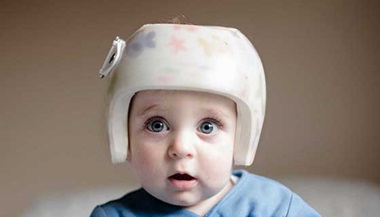Pediatric Craniosynostosis: Causes, Diagnosis, Treatment
When an infant's skull bones fuse together too early, it can create an abnormal head shape. This condition, called pediatric craniosynostosis, is more common than you might think. Craniosynostosis occurs in one out of 2,200 live births and affects males slightly more often than females. Several treatments exist today to safely and effectively treat this condition.
Johns Hopkins pediatric neurosurgeons have successfully guided many babies — and their parents — through this treatment process. Here are answers to some of parents' most common concerns.
What causes craniosynostosis?
The short answer is no one knows precisely what causes this condition. There is likely some genetic component. It's also possible that it's linked to how a baby was positioned in the womb.
Either way, there's nothing you did as a parent to cause this condition, and there are many effective treatments to ensure your child isn't negatively affected by it.
Can craniosynostosis be diagnosed with an ultrasound during pregnancy?
Rarely. There are times when a sonographer might notice something about your baby's head shape while your baby is still in the womb. However, ultrasound technology isn't refined enough to allow for a diagnosis before a baby is born.
Your doctor can likely diagnose this condition soon after your baby is born, as it will become noticeable fairly quickly. This is a good thing: Early treatment can be very effective.
My baby was diagnosed with craniosynostosis with a CT scan. Should I worry about radiation effects?
Many people are concerned about the effects of radiation from excessive imaging. Children, and especially babies, shouldn't be exposed to more radiation than is necessary.
That's why doctors at Johns Hopkins don't use CT scans to diagnose this condition if it is evident from a physical exam. However, if your child does need a CT scan, there's no evidence to show any detrimental effect for babies who undergo one or two CT scans early in their lives.
Is pediatric craniosynostosis surgery safe?
In the past decade, all treatment options for this condition have become safer. At Johns Hopkins, we have a whole team that's dedicated to managing each patient's surgery.
Our pediatric neurosurgical teams use:
- Specialized technology to monitor and correct for any blood loss during surgery
- Advanced technology to monitor babies during surgery
- Proven best practices in sedation
- Comprehensive care methods that follow families from the hospital and through the recovery process
After craniosynostosis surgery, how long does it take for any "lumps and bumps" to go away?
This will vary from child to child. For some children, you'll hardly be able to notice any unevenness along the head as enough time passes after surgery. For other children, there may be gaps (or soft spots) between bones that never grow back.
If these gaps are large enough, your doctor may recommend another, much less involved procedure that can remedy this issue.






